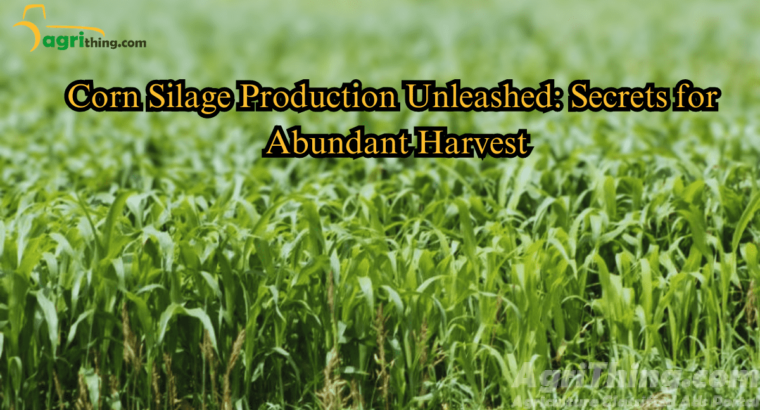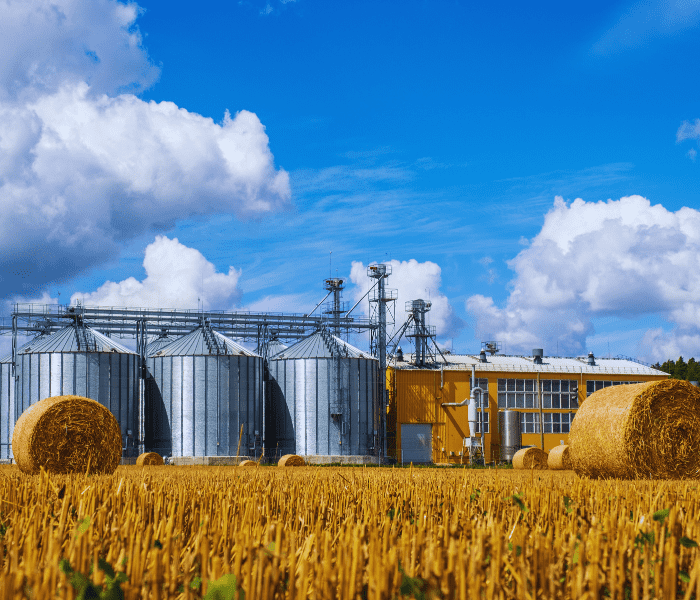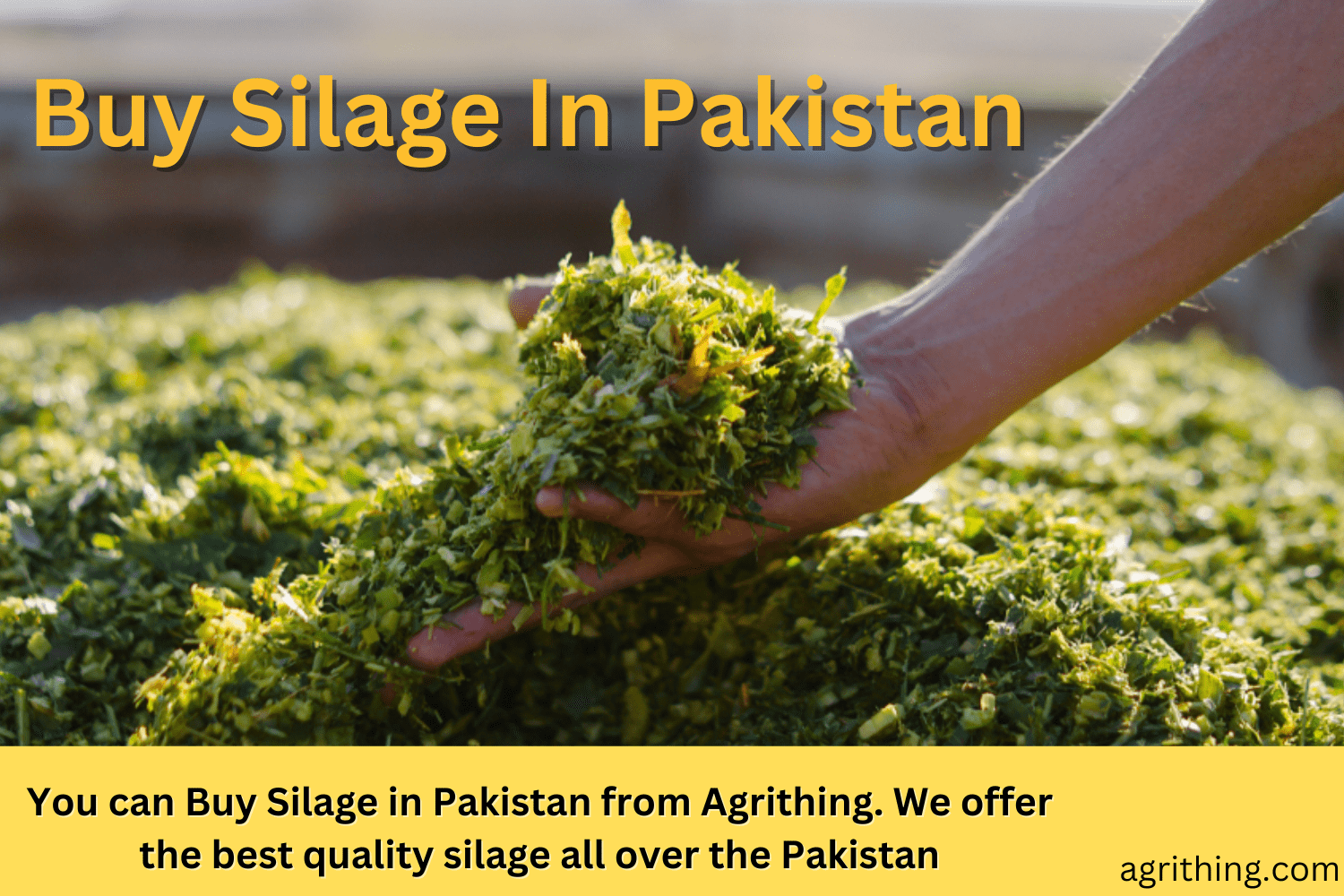5 Surprising Ways to Super Charge Corn Silage Processing

Corn silage processing, also known as making of maize silage , is a high-moisture forage made from chopped corn plants. It serves as a valuable feed for dairy and beef cattle, providing essential nutrients for their growth and well-being. The process of corn silage involves harvesting the entire corn plant, including the stalk, leaves, and ears, and storing it in silos for fermentation.
Corn silage is produced by growing specific corn varieties that are harvested at a specific stage of maturity. The corn plants are chopped into small pieces, and the resulting material is tightly packed into silos or pits.
Table of Contents
Importance of Corn silage processing in Agriculture
Corn silage is important for feeding animals because it has lots of energy and tastes good. It’s a good source of food for dairy and beef cows, especially in places where they can’t graze. It can also help cows make more milk and gain weight.
The Process of Corn silage production
Corn silage is a nutritious food for animals that are made by fermenting chopped corn plants. Let’s look at how Corn silage production it’s made.
1: Harvesting
Corn is picked when it’s at its best. This is usually when the kernels are doughy or starting to dent. The corn has the most nutrients at this stage and still has enough moisture.
2: Chopping
The harvested corn is cut into small pieces using a special machine called a forage harvester. These small pieces are called silage.
3: Packing
The silage is quickly taken to a storage place where it’s compressed to remove as much air as possible. This is really important for the fermentation process. Tractors or machines pack the silage tightly into a bunker, silo, or plastic bag.
4: Ensile
The tightly packed silage is covered with plastic or a special film that blocks oxygen. This makes the silage airtight and prevents it from damaging. Something heavy, like tires or sandbags, is put on top to keep the pressure and airtight conditions.
5: Fermentation
Without oxygen, bacteria in the silage turn the sugars in the corn into acids, mostly lactic acid. This is called fermentation, and it preserves nutrients and makes it easier for animals to digest.
6: Storage and Feedout
The silage ferments for a few weeks to a few months, depending on how good it needs to be. Once it’s done fermenting, it can be stored for a long time. When feeding the silage to animals, it’s important to take it out of storage carefully to keep its quality and stop it from going bad.


Sustainable Practices in Corn silage processing
To make corn silage in a way that doesn’t hurt the environment, we need to use sustainable practices. These practices can help us use fewer resources, take care of the soil, and make less of the gases that cause global warming.
Efficient Irrigation Techniques
Using efficient irrigation methods like drip irrigation or precision sprinklers can improve. How we use water when growing corn for silage. These methods send water straight to the roots, which reduces water loss from evaporation and runoff. By keeping an eye on the moisture levels in the soil and using weather information, we can make irrigation even more effective.
Soil Conservation Methods
By using soil conservation techniques such as conservation tillage, shape plowing, and terracing, we can reduce the erosion of soil. These methods help keep the soil moist, increase the amount of organic matter in it, and protect its structure. Additionally, planting cover crops during periods of inactivity can shield the soil from erosion and improve the way nutrients are circulated.
Alternative Energy Sources
Exploring alternative energy sources, such as solar power or biogas, for corn silage production can reduce reliance on fossil fuels. Solar panels can power irrigation systems and other farm machinery, while biogas systems can convert corn silage waste into renewable energy. These options contribute to a greener and more sustainable production process.
Crop Rotation and Cover Crops
Enforcing crop rotation and cover cropping practices can improve soil health and break pain and disease cycles. Rotating corn with other crops like legumes or small grains can fill soil nutrients and reduce support on synthetic fertilizers. Cover crops, such as clover or rye, can suppress weeds, improve soil structure, and increase biodiversity.
Economic Advantages of Corn silage processing
| Criteria | Production Description |
|---|---|
| Higher Yield | Corn silage typically yields more biomass per acre compared to other forage crops, resulting in increased feed availability for livestock. |
| Lower Production Costs | Corn silage production can be more cost-effective than growing and harvesting other forage crops due to its higher yield potential and lower labor requirements. |
| Reduced Storage Costs | Corn silage can be stored and preserved for extended periods, reducing the need for frequent purchases of fresh forage. This lowers storage and transportation costs. |
| Improved Feed Efficiency | Corn silage provides a high-energy feed source, promoting better digestion and nutrient absorption in livestock, leading to improved feed conversion and potentially reducing feed expenses. |
| Drought Resilience | Corn silage is more resilient to drought conditions compared to other forage crops, as it can withstand dry spells and still provide a substantial feed source for livestock. This resilience can help mitigate the impact of water scarcity on farm operations. |
| Versatility in Feeding Programs | Corn silage can be used as a primary or supplementary feed source, allowing farmers to adjust feeding programs based on their livestock’s nutritional requirements and market conditions. This flexibility helps optimize feed costs. |
| Value-added By-products | Corn silage production often results in valuable by-products, such as corn stover and cobs, which can be utilized for bedding, biofuel production, or as a source of additional revenue for the farm. |
| Extended Grazing Season | Corn silage can extend the grazing season for livestock, providing a reliable source of feed during periods when pasture availability may be limited. This can reduce the need for expensive alternative feed sources. |
Environmental Impact of Corn silage processing
Corn silage has a big impact on the environment when it’s made. We need to know about these effects so we can find ways to make them in a sustainable way that doesn’t hurt the environment.
- Water Usage and Pollution:
- Corn silage processing requires significant water for plant irrigation, straining local water supplies and causing scarcity.
- Rainwater can wash fertilizers and pesticides from cornfields into lakes and rivers, polluting the water and harming aquatic life.
- Soil Erosion and Degradation:
- Intensive Corn silage processing contributes to soil erosion and degradation.
- Harvesting corn removes plant residue, exposing the soil to erosion by wind and water.
- Continuous cultivation of corn depletes soil nutrients, reduces organic matter, and impairs soil structure, negatively impacting fertility and productivity.
- Greenhouse Gas Emissions:
- Corn silage processing generates greenhouse gas emissions, primarily nitrous oxide, and carbon dioxide.
- Nitrous oxide is released from the breakdown of nitrogen-based fertilizers.
- Carbon dioxide is emitted during the fermentation process.
- Biodiversity Loss:
- Converting natural habitats to cornfields for silage production leads to biodiversity loss.
- Loss of diverse plant and animal species disrupts ecosystems, affecting pollination, pest control, and nutrient cycling.
- Pesticide use in corn production can harm beneficial insects and wildlife.


Benefits of Sustainable Corn silage processing
Adopting sustainable practices in Corn silage processing offers several benefits, both for the environment and the farming community.
Reducing the Impact on the Environment
To make corn silage more environmentally friendly, sustainable practices can be implemented. These practices can largely reduce the negative impact on the environment by conserving water, lowering greenhouse gas emissions, and improving soil health.
Better Soil Health
Sustainable methods for producing corn silage promote the health and fertility of the soil. Practices like growing cover crops and rotating crops help replenish nutrients, increase organic matter, and enhance the structure of the soil. Healthy soils result in improved crop yields, better retention of nutrients, and long-term sustainability in agriculture.
Preserving Water Resources
Efficient irrigation techniques and strategies for managing water help conserve water resources in Corn silage processing. By using water more wisely, farmers can lessen the burden on local water supplies and contribute to the conservation of this valuable resource.
Addressing Climate Change
Sustainable Corn silage processing plays a role in mitigating climate change by reducing greenhouse gas emissions. By adopting alternative sources of energy and implementing practices that conserve soil, farmers can contribute to the global effort to decrease carbon emissions and combat the impacts of climate change.
Frequently Asked Question
How does Corn silage processing impact water resources?
Corn silage processing requires substantial water for irrigation, which can strain local water resources. Excessive water usage can lead to water depletion and scarcity. Moreover, runoff from cornfields can carry fertilizers and pesticides into nearby water bodies, causing water pollution.
Can sustainable practices reduce greenhouse gas emissions from Corn silage processing?
Using sustainable practices can help decrease greenhouse gas emissions from corn silage processing. By using alternative sources of energy, implementing efficient irrigation techniques, and adopting soil conservation methods, we can reduce the carbon footprint of producing corn silage.
What are some alternative energy sources used in Corn silage processing?
In Corn silage processing, there are alternative energy sources that can be used, such as solar power and biogas. Solar panels can generate electricity to power irrigation systems and farm machinery, reducing the need for fossil fuels. Biogas systems can convert waste from corn silage into renewable energy, making the process even more sustainable.
How does Corn silage processing affect biodiversity?
Converting natural habitats into cornfields for silage production can have negative effects on biodiversity. It leads to the loss of various plant and animal species, which disrupts ecosystems. This loss can impact important processes like pollination, pest control, and nutrient cycling. Additionally, the use of pesticides in corn production can harm beneficial insects and wildlife.
Are there any economic benefits to adopting sustainable Corn silage processing methods?
There are economic advantages to implementing sustainable practices in Corn silage processing. When resources are used efficiently and soil health improves, farmers can achieve higher crop yields and save on input costs. Furthermore, sustainable practices contribute to the long-term viability and profitability of farming operations.
Conclusion
Corn silage production is important for feeding livestock, but it can harm the environment. To reduce this harm, we need to use sustainable practices. This means using water wisely, taking care of the soil, using different types of energy, and growing different crops. These changes will make Corn silage processing better for the environment. Farmers can help by using these practices. They will protect the environment, make the soil healthier, save water, and fight climate change.
Related Articles
Want to purchase top-quality silage? Visit our Agricomplex website to explore our wide range of silage products.
People Also Asked
How does corn silage production affect the environment?
Corn silage production requires significant water usage, mainly for irrigation purposes. This can lead to increased pressure on water resources and potential water pollution from fertilizer and pesticide runoff.
What are the water usage and pollution concerns in corn silage production?
Corn silage production often involves the removal of natural habitats, leading to the loss of biodiversity. The monoculture nature of corn fields also reduces habitat diversity and can negatively affect wildlife populations.
Are there any biodiversity impacts from corn silage production?
Continuous corn silage production can contribute to soil degradation. Intensive tillage practices, erosion, and nutrient depletion can result in soil erosion, reduced fertility, and increased vulnerability to drought.
How does corn silage production contribute to soil degradation?
Corn silage production requires significant energy inputs, such as fuel for machinery, fertilizer production, and irrigation. This contributes to greenhouse gas emissions and the carbon footprint of the process.
What are the energy requirements and carbon footprint of corn silage production?
Alternative forage crops, such as alfalfa or perennial grasses, can be used instead of corn silage. These crops have lower water requirements, reduce soil erosion, and can support greater biodiversity.




Leave your comment